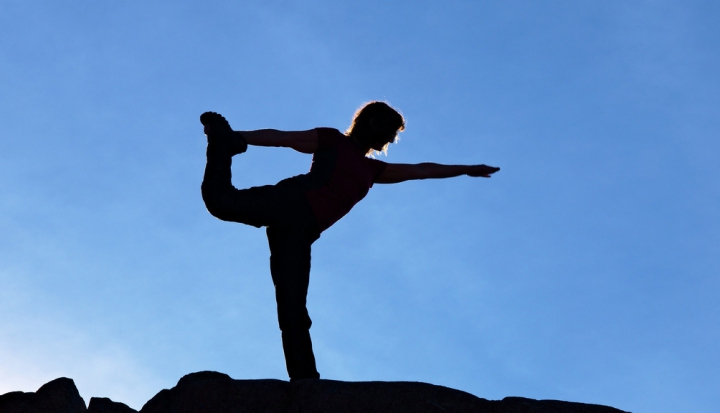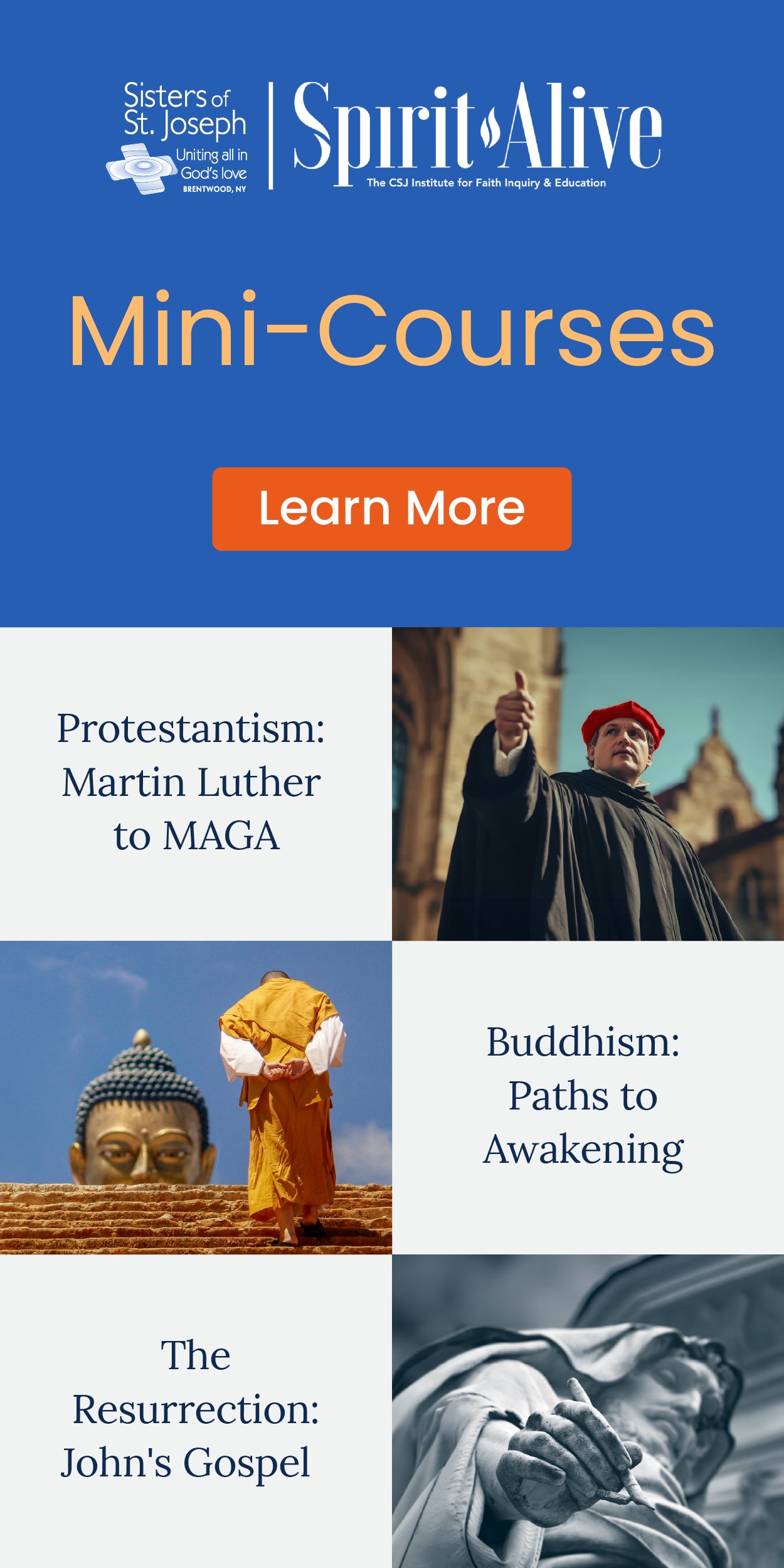Christine French attends Mass every Sunday, sings in the choir, volunteers with Vacation Bible School, and participates in a Bible study. She’s also a committed yogi who, whenever she’s in her hometown of Omaha, makes a beeline to her favorite yoga studio.
“In my head I replace a few of the things they say in class,” says French, a math teacher currently working on the Rosebud Indian Reservation in South Dakota. “When the instructor tells us that we have the power and to trust ourselves in meditations, I often think about how God is in control and I need to surrender to him. We are being asked to spread love, joy, and peace to others, and I think my source of that love, joy, and peace is Jesus. They say [the source is] the universe in class, but I’m capable of making that adjustment in my head.”
Still, she knows some of her Catholic friends and family don’t feel the same, so she tends to keep quiet about her practice. She won’t give it up, though, and here’s why: “Yoga integrates my physical body with my spirituality, something I have never found in the church.”
While yoga causes some Catholic eyebrows to raise, it’s just the tip of the iceberg when it comes to non-Catholic spiritual and religious practices that have made their way into the lives of many Catholics.
Part of that comes from the mainstream acceptance of practices such as yoga, meditation, and holistic healing. Another part comes from a greater visibility and understanding of other religions as well as more personal connections between Catholics and adherents of other religious traditions.
The phenomenon of Catholics engaging in “alternative” spiritual practices is hardly new—Thomas Merton started his dialogue with Buddhist philosophy professor D. T. Suzuki more than 50 years ago. But in the past quarter century alone, church leaders have been particularly focused on the issue. Recent church documents have set forth doctrine (Dominus Iesus, 2000), have urged bishops to respond and caution “those who are interested in some Eastern religions and their particular methods of prayer” (Letter to the Bishops of the Catholic Church on Some Aspects of Christian Meditation, 1989), and have instructed Catholics “to have an understanding of authentic Catholic doctrine and spirituality in order to properly assess New Age themes” (Jesus Christ: The Bearer of the Water of Life, 2003).
In her book Lived Religion: Faith and Practice in Everyday Life (Oxford), religion sociologist Meredith McGuire explains how lived religion doesn’t have to be logically coherent and based on systematic beliefs. Rather, she writes, “It requires a practical coherence: It needs to make sense in one’s everyday life, and it needs to be effective.” Religious practices that promote physical and mental health, improve personal relationships, and help make sense of the world often offer just that, regardless of where they come from.
That’s a challenge for church leaders who are charged with helping Catholics understand what is authentically part of church tradition—and what is even acceptable to church tradition. In 2009, for instance, the U.S. bishops issued Guidelines for Evaluating Reiki as an Alternative Therapy, a document that brought chagrin to Catholics who had used the nonmedical healing technique that originated in Japan more than a century ago.
A Reiki practitioner places his or her hands on or above a patient’s body to restore the flow of “universal life energy,” and, in turn, helps the patient heal physically or spiritually. The bishops’ guidelines state that Reiki “finds no support either in the findings of natural science or in Christian belief” and stress the lack of scientific evidence explaining Reiki’s effectiveness.
In regards to spiritual healing, the guidelines warn: “To use Reiki, one would have to accept, at least in an implicit way, central elements of the worldview that undergirds Reiki theory, elements that belong neither to Christian faith nor natural science.” The guidelines specify that Reiki therapy is inappropriate for Catholic institutions, including health care facilities and retreat centers, because “a Catholic who puts his or her trust in Reiki would be operating in the realm of superstition, the no-man’s-land that is neither faith nor science.”
Cobbling it together
The sociologist Robert Bellah famously wrote in his 1985 groundbreaking book Habits of the Heart (University of California) about “Sheilaism,” a term he picked up from one of his interview subjects, a nurse who had assembled a selection of spiritual truths and named the resulting “religion” after herself.
While Sheila herself was not Catholic, “I think we can say that many people sitting in the pews of Protestant and even Catholic churches are Sheilaists who feel that religion is essentially a private matter and that there is no particular constraint on them placed by the historic church, or even by the Bible and the tradition,” Bellah said in a lecture shortly after the book was published.
The Pew Forum on Religion and Public Life offered supporting evidence of Bellah’s claim when a survey it conducted in 2009 found that 28 percent of Catholics believe in reincarnation, 29 percent believe in astrology, and 17 percent had consulted with psychics or fortune-tellers.
The essential question Catholics need to ask when it comes to assessing a resource from outside their tradition, suggests Paulist Father Thomas Ryan, is what effect it will have on the coherence and integrity of their faith.
Ryan, who directs the Paulist Office for Ecumenical and Interfaith Relations in Washington, takes reincarnation as an example. “For us Christians there’s a beginning and an end. That’s a very different worldview from the traditional Eastern understanding of the cycle of rebirth.” Additionally, the centrality of human effort in the concept of reincarnation conflicts with the centrality of God’s grace that is the core of Catholicism. When Catholics evaluate a non-Catholic resource, Ryan says, “There’s a need for discrimination, discernment, and sometimes rejection.”
But Ryan cautions against rejecting resources outright. “I do think there is a difference between syncretism and enrichment,” he says, pointing to a key theme that runs through Pope John Paul II’s encyclicals Dominum et Vivificantem (1986) and Redemptoris Missio (1990)—that the Holy Spirit is present and active everywhere in the world, not just within the church. “The seeds of the Word are out there. We ought to have our antennae up for what might be edifying and beneficial.”
One example of enrichment involves the “tricycle” of prayer, fasting, and almsgiving—practices that are required of all Christians. “The tire that’s rather flat on that tricycle is fasting. We as Catholics have lost sense of the when, the why, and the how of that practice. When we encounter Muslims who are fasting for Ramadan, from sunrise to sunset, that might lead us to ask, ‘What are we missing?’ and to go back to our own treasure chest and take another look.”
A new lens on faith
For the past four years Tim Brauhn, 27, has fasted during Ramadan with his Muslim friends—something he first tried in his year as a Faiths Act Fellow (a program sponsored by the Tony Blair Faith Foundation in conjunction with the Interfaith Youth Core). “It’s part solidarity, part soul sharpening,” says Brauhn, a Catholic entrepreneur and social media consultant who lives in Denver. He fasts during Lent as well, and his Ramadan experience helps him make sense of what his Lenten practice means.
“When I observe a worship ceremony, or when I participate in a spiritual practice, it’s always complementary,” says Brauhn. “The idea of a deli counter version of religion doesn’t appeal to me. But the moments when I get another lens on my faith help me to move forward.”
Since college Brauhn has spent time in mosques, synagogues, and temples, and he looks for connections between the religious traditions he encounters. In particular, he sees similarities between his own Catholicism and Hinduism—enough that he keeps a statue of Ganesh, the Hindu deity known as the remover of obstacles, on a small home altar along with prayer cards of St. Francis and St. Ignatius. It’s a focal point, Brauhn says, where he’ll sometimes light incense.
When asked whether he’s thinks he’s practicing the kind of syncretism that the Vatican has warned about, Brauhn says no. “Catholicism is my center,” he says, adding that a bigger problem than drawing from other traditions is the dearth of religious literacy among adults, including Catholics. “If you don’t know what you are doing and why [during Mass]—you’re just going through the motions.”
A great spiritual hunger
Susan Stabile, 55, a law professor at the University of St. Thomas in St. Paul, Minnesota and a spiritual director and retreat leader, has never met Brauhn but would agree with him on this point. “I believe there’s danger in people thinking they can pick and choose, but I also think some people have an irrational fear of things that come from other traditions. There’s an enormous difference between drawing from a faith tradition and blending faith traditions,” she says.
“People have an incredibly deep spiritual hunger, and many are not being fed in their own church,” says Stabile, who hopes her new book, Growing in Love and Wisdom: Buddhist Sources for Christian Prayer (Oxford), will help offer sustenance. “Part of my message is, ‘Hey guys, you don’t have to go somewhere else.’ ”
Her message comes from personal experience. After 12 years of parochial school, Stabile gave up her Catholic faith as a high school senior. She graduated from college as an atheist and was introduced to Buddhism during law school. Several years later Stabile moved to Asia, quit her job as a lawyer, and was ordained a Buddhist nun at a Tibetan monastery. She stayed almost four years before deciding to return home to New York.
She continued her Buddhist practice after returning, however, because it had kindled a spiritual awareness that her Catholic upbringing lacked. Eventually she married, had a baby, and started her gradual return to the church when her daughter, then 8, asked for Catholic religious instruction. As part of the religious education program requirements, Stabile started taking her daughter to Sunday Mass.
“I started to hear the gospels in a way that spoke to me,” she says. She later found her way to St. Ignatius Jesuit Retreat House in New York, where she undertook the Spiritual Exercises of St. Ignatius. It changed her life.
“People ask me if I am a Buddhist Christian. I don’t call myself that,” says Stabile. “I am a Christian. I am a Catholic. I take back from Buddhism some things that I use in my Catholic practice.”
That approach works for the Congregation for the Doctrine of the Faith (CDF), which wrote in the 1989 letter on Christian meditation, “One can take from [the great religions] what is useful so long as the Christian conception of prayer, its logic, and requirements are never obscured.”
The CDF also says that “each member of the faithful should seek and find his own way, his own form of prayer. … Each person will, therefore, let himself be led not so much by his personal tastes as by the Holy Spirit, who guides him, through Christ, to the Father.”
The underlying challenge, of course, is that Catholics of all ages are ignorant about the depth of their religious heritage and the richness of its spiritual practices. Stabile remembers how when she told her high school chaplain that she was leaving the church, he couldn’t persuade her to give it a second chance.
“If he had given me Merton’s Seven Storey Mountain or even Augustine’s Confessions, it would have made a difference,” she says. “For a lot of Catholics, the sum total of their prayer is what they recite at Mass and the rote prayers they know from childhood. The piece that’s often missing is the affective experience, the heartfelt knowledge—from thinking and talking about God to feeling and being with God.”
Getting centered
Christine Gallagher started finding that heartfelt knowledge when she took a graduate theology class at Villanova University called Current Contemplative Practices. Her assignment—20 minutes of centering prayer twice a day—wasn’t universally embraced by her classmates, but she found that the method of silent prayer popularized by Trappist Father Thomas Keating worked well after she got the hang of it. “It’s really helped me create a more integrative spirituality,” she says.
A few months into her practice, she remembers the day she decided to do her centering prayer right after she helped out with the stations of the cross last Lent. As usual, she sat with her hands open, palms facing upwards in her lap. But during her prayer, she felt a powerful, painful sensation of her arms being stretched out. “So much of the stations of the cross had been about the pain and agony Christ experienced,” she says. “Through centering prayer, I was able to experience my faith in a deeper and more personal way.”
The prayer form also has helped her to develop her intuition. “I feel like I can sense energy around me, like when people move into a room, or I can sense they’re in a bad mood before they know. I respond better to people because I can ‘feel’ them. That’s something I never hear about in mainstream Catholicism. I want to continue to hone that skill and use it.
“I’m still going to Mass and doing service and am interested in social justice. But centering prayer has taught me to pray and do that authentically. It’s helped me understand who I am and find the Holy Spirit within myself.”
Parish yoga nights
And for many, that’s the goal when they look to outside spiritual traditions. Like Christine French, Ali Niederkorn is a devout Catholic and devoted yogi. Niederkorn, an education and management consultant and certified yoga instructor from the Chicago area, first started practicing yoga a decade ago with the goal of exercise and relaxation. She found much more.
“I was seeing this overlap between how we use our bodies in Mass and how we use our bodies in yoga, and was wondering why no one was talking about it,” she says. In 2007 she attended a workshop given by Paulist Father Ryan, who is a longtime yoga practitioner. “For the first time I heard yoga tied to the Catholic faith, and it was music to my ears,” she says.
Eventually Niederkorn met up with fellow Catholic yogi Dina Wolf, and the pair was encouraged by a young adults group at Old St. Patrick’s Church to come up with a Catholic-friendly yoga class. They struck on the idea of designing a yoga practice to embody the theme of the Sunday readings.
For people who are accustomed to using words and thoughts for prayer, the practice can be both a challenge and a relief. “My weakness is that my mind can get in the way of my communion with God and with others,” says Niederkorn. “The kinesthetic knowing that prayer yoga allows has helped me with discernment. It’s given me an understanding of what light and dark feel like, and helps me understand God’s will even before my brain kicks in.”
The class starts with centering time and an introduction and ends with guided meditation and prayer. Running about 90 minutes, the class typically draws six to 12 people. The parishes that currently offer prayer yoga see it as a ministry rather than just a space to host a yoga class.
“We’ve had many people come for prayer yoga—and, before that, a winter spirituality series on yoga—because they wanted to understand a Christian context for what they were already doing,” says Susan Pudelek, director of pilgrimage ministry at the Shrine of Our Lady of Pompeii in Chicago.
Pudelek sees participation in practices such as yoga or meditation as different from religious traditions such as the Passover Seder or Ramadan. “With yoga, we all have bodies, and they all basically work the same way. These postures help move you to a certain level of calm so you can enter into prayer more deeply.”
On the other hand, the Seder meal—which has a growing popularity among Christians, including as an event at some Catholic parishes—is a Jewish practice that directly relates to their identity, much as the Ramadan fast is for Muslims. If those practices are not done in connection with members of that tradition, Pudelek has reservations.
“I understand the attraction to it, but it can feel a little like taking something and mimicking it. I’ve heard Jews ask, ‘Why are they doing it?’ It’s important to know why you want to do something from another tradition—if it’s to learn about it, or to be in solidarity for a particular reason, maybe. But when it’s not our tradition or identity, we’re only getting the surface, not the full, authentic practice. It’s preferable to have a sense of the tradition, respect it for what it is, and not co-opt it.”
See for yourself
Even if pastoral professionals appreciate yoga, not everyone does—Wolf and Niederkorn have had a few critics over the years. They’ve invited these folks to observe prayer yoga for themselves. Three people took them up on their invitation; two of them seemed satisfied after their initial visit, and one was satisfied enough to become a regular prayer yoga practitioner.
“I fully agree that bringing other religious traditions into [the church] is problematic,” says Niederkorn. “But it’s not that we’re bringing a Hindu practice into the church. It’s a spiritual practice that happened to be used by Hindus but could easily be used by anyone—including Christians.”
Ryan considers the interplay between religious traditions to be one of the particular graces of our age, providing Catholics with regular opportunities to be challenged and inspired to live and understand their faith more fully—and to challenge and inspire others to do the same.
Niederkorn, like so many other Catholics, is deeply grateful for that grace. “I’ve developed a much more personal relationship with God through prayer yoga,” she says. “My challenge is how to take what I experience on the mat and practice that in my everyday life.”
Interested in reading more? Here are two web-exclusive sidebars that accompany this article: Ten ways to determine if a practice is compatible with your Catholic faith and some tips to get you started with drawing from other religions.
This article appeared in the May 2013 issue of U.S. Catholic (Vol. 78, No. 5, pages 12-16).
Image: Flickr photo cc by Tomas Sobek














Add comment